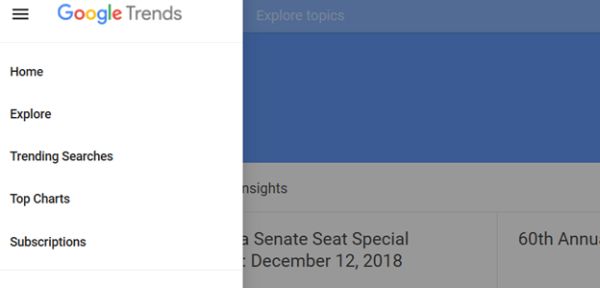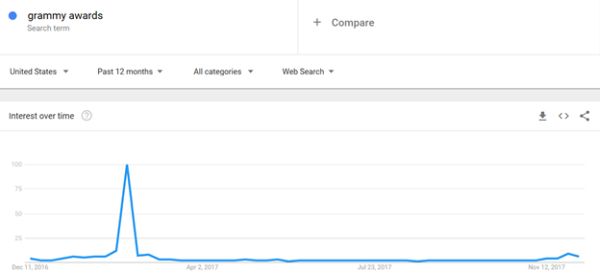
If you’re like me, you love SEO tools – especially free ones!
One of the most underutilized free tools is Google Trends.
Think of Google Trends as your personal barbershop, a place you can turn to get your finger on the pulse of the world.
A word of caution: It’s important to understand how to use it properly and not “discover trends” where none exist.
Here’s what you need to know:
1. Start Big and Whittle Down
In the past, Google Trends had you enter parameters right off the bat — Web Search, Worldwide, etc.
Today’s main dashboard is simpler: it now prompts you to Explore Topics, before you start narrowing down.


A great way to start big? Start by entering in a big-time keyword for your topic and press Enter.
ADVERTISEMENT
CONTINUE READING BELOW
From there, Google Trends invites you to drill down in the following ways:

![]()
- Using Worldwide helps you target a specific market geographically. For example, you’ll see the word “umbrella” peak at different times across different hemispheres.
- Time selection ranges from the “past 5 years,” all the way down to the “past 4 hours.” Pro tip: Use multiple time selections to get an idea of the long-term trends vs. the short-term trends. More on that later.
- Filtering by category is essential. At least if you’re running a search on “Celtic Thunder” and don’t want to read about Irish weather patterns.
- Search Type (including web, news, and YouTube) is another vital category, but more on that in item #3.
With some 10 billion monthly searches in the U.S. alone, the key takeaway here is to start big, then filter to get the most relevant information.
2. Context, Context, Context
Google Trends works in a highly relativistic fashion. The results of today aren’t compared to the overall popularity of all trends, but rather the previous heights of the keywords you entered.
ADVERTISEMENT
CONTINUE READING BELOW
Take the phrase “Caribbean cruise” — an indisputably popular search term. Here’s what you’ll see in the default settings, which includes “Past 12 months.”


On that timeline, it looks like the popularity of Caribbean cruises is down.
But what if we change the date to “2004-present”?


The overall trend looks much more stable. This familiar “heartbeat” pattern is characteristic of seasonal search terms like the Caribbean cruise.
The takeaway: never ignore context.
Try to get rid of your own blind spots before you believe you’ve discovered an insight no one else has.
Other ways of adding context include:
- Using the “+ Compare” tool to add new keywords.
- Filter by country or category
- Web searches
3. Get More Advanced with Specific Search Options
How do you get advanced insights beyond the basics?
You’ll notice five options — many of which even frequent Google Trend users don’t always use:
- Web search (Default)
- Image Search
- News Search
- Google Shopping
- YouTube Search
ADVERTISEMENT
CONTINUE READING BELOW
Each individual click will yield results based on different segments of your potential markets.
You’ll also notice even more options here for sorting popular queries:


Note this is set to certain defaults: it’s showing you the rising trends, which is why in the above example you see the key phrases that have moved up 2,400 percent. Click “Rising,” and you’ll also have the option to view the top overall keywords. Usually, “Rising” is a better option if you want to identify the hot trends.
These suggestions are highly useful for SEO because they can help inspire new content that embraces new trends.
Don’t be afraid to dig down into the queries, either – there’s a good chance that you can hop on a new trend before it becomes a “breakout” and secure a top position for your latest post.
ADVERTISEMENT
CONTINUE READING BELOW
4. Target by Location
The most cursory use of Google Trends will focus exclusively on keywords. For the best results, you’ll also need to incorporate location into the mix. Don’t be afraid to zero in on specific regions and sub-regions – especially when it comes to the U.S.
Using our “Caribbean cruise” trends from earlier, you’ll find that Floridians – or at least, people already in Florida – are the most interested:


Take it a step further with a click on Florida, and you’ll find that the Orlando-Daytona Beach-Melbourne metro region is highest, followed by Miami and then Naples. This is critical data for specific targeting in PPC and even local search.
5. Trend Predictions
It’s the easiest thing in the world to log on to Google Trends and identify those trends that already leave a trail of breadcrumbs. The problem? Every other search engine marketer is using the same data.
ADVERTISEMENT
CONTINUE READING BELOW
If you want additional insights, try using the available data to predict trends.
Not long ago, the practice of “newsjacking” was a sure way to capitalize on current hot stories. Google Trends can indeed show you exactly which news trends of the day are the hottest.
There are a few ways to do this:
- Identify trends with filtering by specific categories or countries. Today’s top health story might not make major headlines in Google Trends, but it can help you identify topics to watch.
- Compare two key phrases in a single trend. Is “Vote for X” trending higher than “Vote for Y”? You might have yourself an informal poll.
6. Use Long-Tail Key Phrases to Inspire Content
Ranking at the top of the SERPs for “Caribbean Cruise” is quite an undertaking, but there’s no reason you can’t get to the top of Google search results for a long-tail variation of a trophy phrase.
Switching gears, let’s say you’re writing a music blog and you want to leverage an upcoming event; the Grammy awards. A click on the trend will yield top questions asked Google, most searched best new artists, and even questions related to the host of the Grammys — such as “how old is James Corden”?
ADVERTISEMENT
CONTINUE READING BELOW
But you want to go deeper and find content that’s truly insightful. Try using tip #3 to find the associated queries making Google Trends — but don’t stop there. Cross-reference those queries with each other (ala tip #2) to get a proper context and find out what’s at the core of customer curiosity.
7. Use “Top Charts” For Additional Insights
Clicking on the icon in the upper left, browse over to Top Charts:


As Google explains, Top Charts is different than the trends most people are watching. Think of this as the “Billboard Top 100” of Google; you’ll see the top trending items in a variety of categories.
As of right now, the top trending animal is the deer. Who knew?
Sort between Trending and Most Searched for additional insights. There you’ll find that the dog rules supreme over the cat — and the deer’s popularity is most likely related to the recent deer hunting season. In search, context is everything.
ADVERTISEMENT
CONTINUE READING BELOW
8. Use Data for Video Optimization
Let’s say you posted a video on how to get discounts on Caribbean cruises.
- Enter in your search term.
- Switch from Web Search to YouTube Search.
- Check out Related Queries and Related Topics.
- Sort by Top or Rising — if you prefer.
From here, you’ll find that people search cruises based on ship classes, not just by searching the ships themselves. Armed with this knowledge, you are in a better position to write relevant titles and descriptions. This improves your opportunity to capture YouTube traffic, as cruise season rolls around.
9. Use Cyclical Trends for Brand Positioning
Let’s say you’re optimizing a wedding boutique. A simple search of wedding shows the reality of wedding season on Google:


From this, you can glean that weddings don’t compete with holidays.
ADVERTISEMENT
CONTINUE READING BELOW
Using some of the strategies above, however, you can find some additional keywords to position future posts to handle the return of each cyclical trend.
When your competition is just writing a post on a selection of wedding songs, yours is already up — and capturing views.
10. Identify Blind Spots & Don’t Misread the Trends
Let’s return to one of the current trends, the Grammy Awards. The recent spike suggests a strong interest in the topic.
But what if you zoom out to a longer timeline?


It demonstrates that once the initial buzz wears off, it will dip right back down to its usual rate.
Advanced use of Google Trends means you’ll go a step beyond whatever you think your current insight is to see if you have blind spots.
ADVERTISEMENT
CONTINUE READING BELOW
For example:
- Don’t ever trust a single snapshot. Always get a broader view of a timeline to see what else is happening.
- Is an increased trend in one key phrase still dwarfed by more important ones? Always look for context.
- Researching weddings for #9, I encountered a drastic increase in YouTube trends for weddings during the summer of 2017 – far greater than in previous summers – which almost quadrupled previous interest. Further research couldn’t identify a specific keyword, except to show a drastic increase in wedding interest in South Asia. This geographically-driven trend is a great example of a unique insight that comes from the never-ending search for understanding context.
Summary
Although Google Trends has changed a lot over the years, the principles remain the same: there are unique insights to be gleaned for those willing to go beyond a basic search. The key is sticking with your queries until you find the insights – even if they aren’t always obvious.
More Google Trends Resources Here:
Image Credits
Featured Image: geralt / Pixabay
Screenshots by Chuck Price. Taken December 2017.
ADVERTISEMENT
CONTINUE READING BELOW
Category

